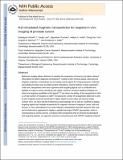M13-templated magnetic nanoparticles for targeted in vivo imaging of prostate cancer
Author(s)
Ghosh, Debadyuti; Lee, Youjin; Thomas, Stephanie; Kohli, Aditya G.; Yun, Dong Soo; Kelly, Kimberly A.; Belcher, Angela M; ... Show more Show less
DownloadBelcher_M13 templated.pdf (584.0Kb)
PUBLISHER_POLICY
Publisher Policy
Article is made available in accordance with the publisher's policy and may be subject to US copyright law. Please refer to the publisher's site for terms of use.
Terms of use
Metadata
Show full item recordAbstract
Molecular imaging allows clinicians to visualize the progression of tumours and obtain relevant information for patient diagnosis and treatment1. Owing to their intrinsic optical, electrical and magnetic properties, nanoparticles are promising contrast agents for imaging dynamic molecular and cellular processes such as protein–protein interactions, enzyme activity or gene expression2. Until now, nanoparticles have been engineered with targeting ligands such as antibodies and peptides to improve tumour specificity and uptake. However, excessive loading of ligands can reduce the targeting capabilities of the ligand3, 4, 5 and reduce the ability of the nanoparticle to bind to a finite number of receptors on cells6. Increasing the number of nanoparticles delivered to cells by each targeting molecule would lead to higher signal-to-noise ratios and would improve image contrast. Here, we show that M13 filamentous bacteriophage can be used as a scaffold to display targeting ligands and multiple nanoparticles for magnetic resonance imaging of cancer cells and tumours in mice. Monodisperse iron oxide magnetic nanoparticles assemble along the M13 coat, and its distal end is engineered to display a peptide that targets SPARC glycoprotein, which is overexpressed in various cancers. Compared with nanoparticles that are directly functionalized with targeting peptides, our approach improves contrast because each SPARC-targeting molecule delivers a large number of nanoparticles into the cells. Moreover, the targeting ligand and nanoparticles could be easily exchanged for others, making this platform attractive for in vivo high-throughput screening and molecular detection.
Date issued
2012-09Department
Massachusetts Institute of Technology. Department of Biological Engineering; Massachusetts Institute of Technology. Department of Materials Science and Engineering; Koch Institute for Integrative Cancer Research at MITJournal
Nature Nanotechnology
Publisher
Nature Publishing Group
Citation
Ghosh, Debadyuti, Youjin Lee, Stephanie Thomas, Aditya G. Kohli, Dong Soo Yun, Angela M. Belcher, and Kimberly A. Kelly. “M13-Templated Magnetic Nanoparticles for Targeted in Vivo Imaging of Prostate Cancer.” Nature Nanotechnology 7, no. 10 (September 16, 2012): 677–682.
Version: Author's final manuscript
ISSN
1748-3387
1748-3395